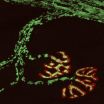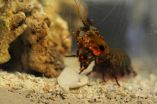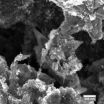(Press-News.org) JUPITER, FL, April 22, 2014 – Scientists from the Florida campus of The Scripps Research Institute (TSRI) have identified a protein complex that plays a critical but previously unknown role in learning and memory formation.
The study, which showed a novel role for a protein known as RGS7, was published April 22, 2014 in the journal eLife, a publisher supported by the Howard Hughes Medical Institute, the Max Planck Society and the Wellcome Trust.
"This is a critical building block that regulates a fundamental process—memory," said Kirill Martemyanov, a TSRI associate professor who led the study. "Now that we know about this important new player, it offers a unique therapeutic window if we can find a way to enhance its function."
The team looked at RGS7 in the hippocampus, a small part of the brain that helps turn short-term memory in long-term memory.
The scientists found the RGS7 protein works in concert with another protein, R7BP, to regulate a key signaling cascade that is increasingly seen as a critical to cognitive development. The cascade involves the neurotransmitter GABA, which binds to the GABAb receptor and opens inhibitory channels known as GIRKs in the cell membrane. This process ultimately makes it more difficult for a nerve cell to fire.
This process turned out to be critical to normal functioning, as the research showed mice lacking RGS7 exhibited deficits in learning and memory.
Martemyanov believes the findings could ultimately have broad therapeutic application. "GIRK channels are implicated in a range of neuropsychiatric conditions, including drug addiction and Down's syndrome, that result from a disproportionate increase in neuronal inhibition as a result of greater mobilization of these channels," he said. "Now that we know the identity of the critical modulator of GIRK channels we can try to find a way to increase its power with the hopes of reducing the inhibitory overdrive, and that might potentially alleviate some of the disruptions seen in Down's syndrome. It is possible that similar strategies might apply for dealing with addiction, where adaptations in the GABAb-GIRK pathway play a significant role."
Targeting the RGS7 protein could allow for better therapeutic outcomes with fewer side effects because it allows for fine tuning of the signaling, according to Olga Ostrovskaya, the first author of the study and a member of Martemyanov's lab, who sees many ways to follow up on the findings.
"We're looking into how RGS7 is involved in neural circuitry and functions tied to the striatum, another part of the brain responsible for procedural memory, mood disorders, motivation and addiction," Ostrovskaya said. "We may uncover the RGS7 regulation of other signaling complexes that may be very different from those in hippocampus."
INFORMATION:
In addition to Ostrovskaya and Martemyanov, other authors of the study, "RGS7/Gβ5/R7BP Complex Regulates Synaptic Plasticity and Memory by Modulating Hippocampal Gababr-Girk Signaling," include Keqiang Xie and Ikuo Masuho of TSRI; Ana Fajardo-Serrano and Rafael Lujan of the Universidad de Castilla-La Mancha, Albacete, Spain; and Kevin Wickman of the University of Minnesota. To view the paper, visit elifesciences.org/lookup/doi/10.7554/elife.02053
The study was supported by the National Institutes of Health (Grants DA021743, DA026405, MH061933, DA034696, HL105550) and by grants from the Spanish Ministry of Education and Science (BFU-2012-38348) and CONSOLIDER (CSD2008-00005).
Scientists identify critical new protein complex involved in learning and memory
2014-04-22
ELSE PRESS RELEASES FROM THIS DATE:
Almost one-third of Canadian adults have experienced child abuse
2014-04-22
Almost one-third of adults in Canada have experienced child abuse — physical abuse, sexual abuse or exposure to intimate partner (parents, step-parents or guardians) violence in their home. As well, child abuse is linked to mental disorders and suicidal ideation (thoughts) or suicide attempts, found an article published in CMAJ (Canadian Medical Association Journal).
"From a public health standpoint, these findings highlight the urgent need to make prevention of child abuse a priority in Canada," writes Dr. Tracie Afifi, departments of Community Health Sciences and Psychiatry, ...
Multiple sclerosis: A review of current treatments for physicians
2014-04-22
A review of the literature on treating multiple sclerosis (MS) aims to provide physicians with evidence-based information on the latest treatments for this chronic disease. The article, published in CMAJ (Canadian Medical Association Journal) looks at the latest pharmacologic research as well as disease-modifying agents and the benefits and risks of various treatments.
"Recently, several new compounds have been developed and approved with the aim of favourably changing the disease course, but with varied success," writes Dr. Loredana La Mantia, Cochrane Multiple Sclerosis ...
Neuroimaging: Live from inside the cell
2014-04-22
This news release is available in German.
Reactive oxygen species are important intracellular signaling molecules, but their mode of action is complex: In low concentrations they regulate key aspects of cellular function and behavior, while at high concentrations they can cause "oxidative stress", which damages organelles, membranes and DNA. To analyze how redox signaling unfolds in single cells and organelles in real-time, an innovative optical microscopy technique has been developed jointly by the teams of LMU Professor Martin Kerschensteiner and TUM Professor ...
Research shows impact of Facebook unfriending
2014-04-22
DENVER (April 22, 2014) – Two studies from the University of Colorado Denver are shedding new light on the most common type of `friend' to be unfriended on Facebook and their emotional responses to it.
The studies, published earlier this year, show that the most likely person to be unfriended is a high school acquaintance.
"The most common reason for unfriending someone from high school is that the person posted polarizing comments often about religion or politics," said Christopher Sibona, a doctoral student in the Computer Science and Information Systems program at ...
AMP publishes curriculum recommendations for medical laboratory scientists
2014-04-22
Bethesda, MD, April 22, 2014: The Association for Molecular Pathology (AMP) released a report today in The Journal of Molecular Diagnostics on recommendations for a molecular diagnostics curriculum at both the baccalaureate and master's levels of education. The report was prepared by the Medical Laboratory Scientist (MLS) Curriculum Task Force of the AMP Training and Education Committee. "Our goal was to address the critical need of educating future medical laboratory scientists appropriately in order to manage the rapidly growing and changing realm of molecular diagnostic ...
New patenting guidelines are needed for biotechnology
2014-04-22
HOUSTON – (April 22, 2014) – Biotechnology scientists must be aware of the broad patent landscape and push for new patent and licensing guidelines, according to a new paper from Rice University's Baker Institute for Public Policy.
Published in the current issue of the journal Regenerative Medicine, the paper is based on the June 2013 U.S. Supreme Court ruling in the case Association for Molecular Pathology (AMP) v. Myriad Genetics that naturally occurring genes are unpatentable. The court case and rulings garnered discussion in the public about patenting biological materials.
"The ...
Mantis shrimp stronger than airplanes
2014-04-22
RIVERSIDE, Calif. — Inspired by the fist-like club of a mantis shrimp, a team of researchers led by University of California, Riverside, in collaboration with University of Southern California and Purdue University, have developed a design structure for composite materials that is more impact resistant and tougher than the standard used in airplanes.
"The more we study the club of this tiny crustacean, the more we realize its structure could improve so many things we use every day," said David Kisailus, a Kavli Fellow of the National Academy of Science and the Winston ...
NASA gets 2 last looks at Tropical Cyclone Jack
2014-04-22
VIDEO:
This 3-D flyby from NASA's TRMM satellite of Tropical Cyclone Jack on April 21 shows that some of the thunderstorms were shown by TRMM PR were still reaching height of...
Click here for more information.
Tropical Cyclone Jack lost its credentials today, April 22, as it no longer qualified as a tropical cyclone. However, before it weakened, NASA's TRMM satellite took a "second look" at the storm yesterday.
The Tropical Rainfall Measuring Mission or TRMM satellite had two ...
High-performance, low-cost ultracapacitors built with graphene and carbon nanotubes
2014-04-22
WASHINGTON D.C., April 22, 2014 -- By combining the powers of two single-atom-thick carbon structures, researchers at the George Washington University's Micro-propulsion and Nanotechnology Laboratory have created a new ultracapacitor that is both high performance and low cost.
The device, described in the Journal of Applied Physics, capitalizes on the synergy brought by mixing graphene flakes with single-walled carbon nanotubes, two carbon nanostructures with complementary properties.
Ultracapacitors are souped-up energy storage devices that hold high amounts of energy ...
International team sequences rainbow trout genome
2014-04-22
PULLMAN, Wash.—Using fish bred at Washington State University, an international team of researchers has mapped the genetic profile of the rainbow trout, a versatile salmonid whose relatively recent genetic history opens a window into how vertebrates evolve.
The 30-person team, led by Yann Guiguen of the French National Institute for Agricultural Research, reports its findings this week in Nature Communications.
The investigators focused on the rate at which genes have evolved since a rare genome doubling event occurred in the rainbow trout approximately 100 million years ...




